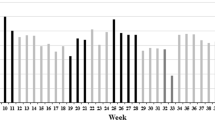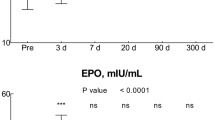Abstract
Decreased oxygen availability in sojourners requires adjustments in tissue oxygen supply, the most effective of which is an increase in the hemoglobin (Hb) concentration. It is achieved by two independent processes: a fast increase in Hb is achieved by decreasing plasma volume due to enhanced renal Na- and water excretion. A further but slow increase in Hb concentration is achieved by stimulation of erythropoiesis by mechanisms depending on stabilization of hypoxia-inducible factor 2α resulting in elevated levels of erythropoietin in blood. The magnitude of decrease in plasma volume and of stimulation of erythropoiesis depends on the degree and duration of exposure to hypoxia at high altitude. Upon descent from high to low altitude elevated O2-transport capacity is no longer needed. Thus, plasma volume can be restored and excess erythrocytes can be removed from circulation. This latter process is called erythrolysis. Its effectiveness seems to depend on the altitude to which individuals had been exposed. Whereas most of the excess erythrocytes seem to be removed from circulation within 1–2 weeks after a stay at altitudes > 3500 m, total Hb mass seems to remain elevated for up to 4 weeks when individuals had been exposed to more moderate altitudes, e.g. in the range of 2500 m. These are the altitudes where athletes typically perform altitude training. Thus, it appears that improved performance in the weeks after return from altitude training depends in part on maintaining elevated total Hb mass, which is known to increase aerobic capacity.

Similar content being viewed by others
References
Alfrey CP, Rice L, Udden MM, Driscoll TB. Neocytolysis: physiological down-regulator of red-cell mass. Lancet. 1997;349(9062):1389–90. https://doi.org/10.1016/S0140-6736(96)09208-2(PubMed PMID: 9149714).
Bärtsch P, Swenson ER. Clinical practice: acute high-altitude illnesses. N Engl J Med. 2013;368(24):2294–302. https://doi.org/10.1056/NEJMcp1214870(PubMed PMID: 23758234).
Bärtsch P, Swenson ER, Paul A, Julg B, Hohenhaus E. Hypoxic ventilatory response, ventilation, gas exchange, and fluid balance in acute mountain sickness. High Altit Med Biol. 2002;3(4):361–76. https://doi.org/10.1089/15270290260512846PubMed PMID: 12631422.
Beall CM. Andean, Tibetan, and Ethiopian patterns of adaptation to high-altitude hypoxia. Integr Comp Biol. 2006;46(1):18–24.
Berlin NI, Reynafarje C, Lawrence JH. Red cell life span in the polycythemia of high altitude. J Appl Physiol. 1954;7(3):271–2.
Bouverot P. Adaptation to altitude hypoxia in vertebrates. Berlin: Springer Verlag; 1985.
Brutsaert TD. Do high-altitude natives have enhanced exercise performance at altitude? Appl Physiol Nutr Metab. 2008;33(3):582–92. https://doi.org/10.1139/h08-009(Epub 2008/05/08. PubMed PMID: 18461115).
Calbet JA, Boushel R, Radegran G, Sondergaard H, Wagner PD, Saltin B. Why is VO2 max after altitude acclimatization still reduced despite normalization of arterial O2 content? Am J Physiol. 2003;284(2):R304–16. https://doi.org/10.1152/ajpregu.00156.2002.
Chapman RF, StrayGundersen J, Levine BD. Individual variation in response to altitude training. J Appl Physiol. 1998;85(4):1448–56.
Chapman RF, Laymon Stickford AS, Lundby C, Levine BD. Timing of return from altitude training for optimal sea level performance. J Appl Physiol. 2014;116(7):837–43. https://doi.org/10.1152/japplphysiol.00663.2013PubMed PMID: 24336885.
Christensen RD, Lambert DK, Henry E, Yaish HM, Prchal JT. End-tidal carbon monoxide as an indicator of the hemolytic rate. Blood Cells Mol Dis. 2015;54(3):292–6. https://doi.org/10.1016/j.bcmd.2014.11.018(PubMed PMID: 25624169).
Cremona G, Asnaghi P, Baderna P, Brunetto A, Brutsaert T, Cavallaro C, Clark TM, Cogo A, Donis R, Lanfranchi P, Luks A, Novello N, Panzetta S, Perini L, Putnam M, Spagnolatti L, Wagner H, Wagner PD. Pulmonary extravascular fluid accumulation in recreational climbers: a prospective study. Lancet. 2002;359(9303):303–9.
Dempsey JA, Reddan WG, Birnbaum ML, Forster HV, Thoden JS, Grover RF, Rankin J. Effects of acute through life-long hypoxic exposure on exercise pulmonary gas exchange. Respir Physiol. 1971;13(1):62–89 Epub 1971/10/01 PubMed PMID: 5112830.
Faulkner JA, Daniels JT, Balke B. Effects of training at moderate altitude on physical performance capacity. J Appl Physiol. 1967;23(1):85–9.
Fryers GR, Berlin NI. Mean red cell life of rats exposed to reduced barometric pressure. Am J Physiol. 1952;171(2):465–70 Epub 1952/11/01 PubMed PMID: 13007817.
Garvican L, Martin D, Quod M, Stephens B, Sassi A, Gore C. Time course of the hemoglobin mass response to natural altitude training in elite endurance cyclists. Scand J Med Sci Sports. 2012;22(1):95–103. https://doi.org/10.1111/j.1600-0838.2010.01145.x(Epub 2010/06/22. PubMed PMID: 20561279).
Garvican-Lewis LA, Sharpe K, Gore CJ. Time for a new metric for hypoxic dose? J Appl Physiol. 2016;121(1):352–5. https://doi.org/10.1152/japplphysiol.00579.2015(Epub 2016/02/27. PubMed PMID: 26917695).
Gassmann M, Muckenthaler MU. Adaptation of iron requirement to hypoxic conditions at high altitude. J Appl Physiol. 2015;119(12):1432–40. https://doi.org/10.1152/japplphysiol.00248.2015(PubMed PMID: 26183475).
Hannon JP, Vogel JA. Oxygen transport during early altitude acclimatization: a perspectiv study. Eur J Appl Physiol Occup Physiol. 1977;36(4):285–97.
Hentze MW, Muckenthaler MU, Galy B, Camaschella C. Two to tango: regulation of Mammalian iron metabolism. Cell. 2010;142(1):24–38.
Hohenhaus E, Paul A, McCullough RE, Kücherer H, Bärtsch P. Ventilatory and pulmonary vascular response to hypoxia and susceptibility to high altitude pulmonary oedema. Eur Respir J. 1995;8(11):1825–33.
Huff RL, Lawrence JH, Siri WE, Wasserman LR, Hennessy TG. Effects of changes in altitude on hematopoietic activity. Medicine (Baltimore). 1951;30(3):197–217 PubMed PMID: 14881989.
Kjellberg SR, Rudhe U, Sjostrand T. Increase of the amount of hemoglobin and blood volume in connection with physical training. Acta Physiol Scand. 1949;19(2–3):146–52.
Klausen K, Dill DB, Horvath SM. Exercise at ambient and high oxygen pressure at high altitude and at sea level. J Appl Physiol. 1970;29(4):456–63. https://doi.org/10.1152/jappl.1970.29.4.456(Epub 1970/10/01. PubMed PMID: 5459913).
Landaw SA. Factors that accelerate or retard red blood cell senescence. Blood Cells. 1988;14(1):47–59.
Levine BD, Stray-Gundersen J. “Living high-training low”: effect of moderate-altitude acclimatization with low-altitude training on performance. J Appl Physiol. 1997;83(1):102–12.
Lundby C, Millet GP, Calbet JA, Bärtsch P, Subudhi AW. Does ‘altitude training’ increase exercise performance in elite athletes? Br J Sports Med. 2012;46(11):792–5.
Mairbäurl H. Red blood cells in sports: effects of exercise and training on oxygen supply by red blood cells. Front Physiol. 2013. https://doi.org/10.3389/fphys.2013.00332.
Mairbäurl H, Weber RE. Oxygen transport by hemoglobin. Compr Physiol. 2012;2(2):1463–89.
Mairbäurl H, Schobersberger W, Oelz O, Bärtsch P, Eckardt KU, Bauer C. Unchanged in vivo P 50 at high altitude despite decreased red cell age and elevated 2,3-DPG. J Appl Physiol. 1990;68(3):1186–94.
Merino CF. Studies on blood formation and destruction in the polycythemia of high altitude. Blood. 1950;5(1):1–31 PubMed PMID: 15396777.
Milledge JS. Renin-Aldosterone System. In: West JB, Lahiri S, editors. High altitude and man. Bethesda: Williams & Wilkins; 1984. p. 47–57.
Milledge JS. Salt and water control at altitude. Int J Sports Med. 1992;13(Suppl 1):S61–3.
Milledge JS, Bryson EI, Catley DM, Hesp R, Luff N, Minty BD, Older MW, Payne NN, Ward MP, Withey WR. Sodium balance, fluid homeostasis and the renin-aldosterone system during the prolonged exercise of hill walking. Clin Sci (Lond). 1982;62(6):595–604.
Ohi H, Tamano M, Sudo S, Okada N. Recombinant EPO therapy increases erythrocyte expression of complement regulatory proteins. Am J Kidney Dis. 2003;41(1):179–85. https://doi.org/10.1053/ajkd.2003.50002(Epub 2002/12/25. PubMed PMID: 12500235).
Olsen NV. Ventilation, hypocapnia and hypoxia: Effects on renal function. In: Houston CS, Coates G, editors. Hypoxia: women at high altitude. Burlington: Queen City Printers; 1997. p. 284–99.
Olsen NV, Hansen JM, Kanstrup IL, Leyssac OO. Renal hemodynamics, tubular function, and response to low-dose dopamine during acute hypoxia in humans. J Appl Physiol. 1993;74(5):2166–73.
Pace N, Meyer LB, Vaughan BE. Erythrolysis on return of altitude acclimatized individuals to sea level. J Appl Physiol. 1956;9(2):141–4 PubMed PMID: 13376417.
Prommer N, Thoma S, Quecke L, Gutekunst T, Volzke C, Wachsmuth N, Niess AM, Schmidt W. Total hemoglobin mass and blood volume of elite Kenyan runners. Med Sci Sports Exerc. 2010;42(4):791–7. https://doi.org/10.1249/mss.0b013e3181badd67(Epub 2009/12/03. PubMed PMID: 19952848).
Rasmussen P, Siebenmann C, Diaz V, Lundby C. Red cell volume expansion at altitude: a meta-analysis and Monte Carlo simulation. Med Sci Sports Exerc. 2013;45(9):1767–72. https://doi.org/10.1249/MSS.0b013e31829047e5PubMed PMID: 23502972.
Reynafarje C, Lozano R, Valdivieso J. The polycythemia of high altitudes: iron metabolism and related aspects. Blood. 1959;14(4):433–55.
Rice L, Ruiz W, Driscoll T, Whitley CE, Tapia R, Hachey DL, Gonzales GF, Alfrey CP. Neocytolysis on descent from altitude: a newly recognized mechanism for the control of red cell mass. Ann Intern Med. 2001;134(8):652–6 PubMed PMID: 11304105.
Rifkind RA. Destruction of injured red cells in vivo. Am J Med. 1966;41(5):711–23 (Epub 1966/11/01 PubMed PMID: 5332170).
Risso A, Turello M, Biffoni F, Antonutto G. Red blood cell senescence and neocytolysis in humans after high altitude acclimatization. Blood Cells Mol Dis. 2007;38(2):83–92. https://doi.org/10.1016/j.bcmd.2006.10.161(PubMed PMID: 17188915).
Risso A, Ciana A, Achilli C, Antonutto G, Minetti G. Neocytolysis: none, one or many? A reappraisal and future perspectives. Front Physiol. 2014;5:54. https://doi.org/10.3389/fphys.2014.00054(PubMed PMID: 24592241; PubMed Central PMCID: PMCPMC3924315).
Rodriguez FA, Iglesias X, Feriche B, Calderon-Soto C, Chaverri D, Wachsmuth NB, Schmidt W, Levine BD. Altitude training in elite swimmers for sea level performance (Altitude Project). Med Sci Sports Exerc. 2015;47(9):1965–78. https://doi.org/10.1249/mss.0000000000000626(Epub 2015/01/30. PubMed PMID: 25628173).
Rogers SC, Said A, Corcuera D, McLaughlin D, Kell P, Doctor A. Hypoxia limits antioxidant capacity in red blood cells by altering glycolytic pathway dominance. FASEB J. 2009;23(9):3159–70. https://doi.org/10.1096/fj.09-130666(PubMed PMID: 19417084; PubMed Central PMCID: PMCPMC2735367).
Rusko HK, Tikkanen HO, Peltonen JE. Altitude and endurance training. J Sports Sci. 2004;22(10):928–44.
Sawka MN, Convertino VA, Eichner ER, Schnieder SM, Young AJ. Blood volume: importance and adaptations to exercise training, environmental stresses, and trauma/sickness. Med Sci Sports Exerc. 2000;32(2):332–48.
Schmidt W, Prommer N. Impact of alterations in total hemoglobin mass on VO2max. Exerc Sport Sci Rev. 2010;38(2):68–75.
Siebenmann C, Cathomen A, Hug M, Keiser S, Lundby AK, Hilty MP, Goetze JP, Rasmussen P, Lundby C. Hemoglobin mass and intravascular volume kinetics during and after exposure to 3454-m altitude. J Appl Physiol. 2015;119(10):1194–201. https://doi.org/10.1152/japplphysiol.01121.2014(PubMed PMID: 25749449).
Siebenmann C, Robach P, Lundby C. Regulation of blood volume in lowlanders exposed to high altitude. J Appl Physiol. 2017;123(4):957–66. https://doi.org/10.1152/japplphysiol.00118.2017(Epub 2017/06/03. PubMed PMID: 28572493).
Song J, Sundar K, Gangaraju R, Prchal JT. Regulation of erythropoiesis after normoxic return from chronic sustained and intermittent hypoxia. J Appl Physiol. 2017;123(6):1671–5. https://doi.org/10.1152/japplphysiol.00119.2017(Epub 2017/05/20. PubMed PMID: 28522758).
Stray-Gundersen J, Levine BD. Live high, train low at natural altitude. Scand J Med Sci Sports. 2008;18(Suppl 1):21–8.
Sutton JR. Exercise training at high altitude: does it improve endurance performance at sea level? Gatorade Sports Sci Inst. 1993;6:45–58.
Swenson ER, Bärtsch P. High-altitude pulmonary edema. Compr Physiol. 2012;2(4):2753–73. https://doi.org/10.1002/cphy.c100029(PubMed PMID: 23720264).
Swenson ER, Maggiorini M, Mongovin S, Gibbs JSR, Greve I, Mairbäurl H, Bärtsch P. Pathogenesis of high-altitude pulmonary edema: inflammation is not an etiologic factor. J Am Med A. 2002;287(17):2228–35.
Sylvester JT, Shimoda LA, Aaronson PI, Ward JP. Hypoxic pulmonary vasoconstriction. Physiol Rev. 2012;92(1):367–520.
Trial J, Rice L, Alfrey CP. Erythropoietin withdrawal alters interactions between young red blood cells, splenic endothelial cells, and macrophages: an in vitro model of neocytolysis. J Investig Med. 2001;49(4):335–45. https://doi.org/10.2310/6650.2001.33899(PubMed PMID: 11478410).
Viault F. Sur la quantite d’oxygene contenue dans la sang des animoux des hauts plateaux de l’Amerique du Sud. CRH Acad Sci Paris. 1891;112:295.
Wachsmuth NB, Volzke C, Prommer N, Schmidt-Trucksass A, Frese F, Spahl O, Eastwood A, Stray-Gundersen J, Schmidt W. The effects of classic altitude training on hemoglobin mass in swimmers. Eur J Appl Physiol. 2013;113(5):1199–211. https://doi.org/10.1007/s00421-012-2536-0(Epub 2012/11/10. PubMed PMID: 23138148).
Wachsmuth N, Kley M, Spielvogel H, Aughey RJ, Gore CJ, Bourdon PC, Hammond K, Sargent C, Roach GD, Sanchez RS, Claros JC, Schmidt WF, Garvican-Lewis LA. Changes in blood gas transport of altitude native soccer players near sea-level and sea-level native soccer players at altitude (ISA3600). Br J Sports Med. 2013;47(Suppl 1):i93–9. https://doi.org/10.1136/bjsports-2013-092761(Epub 2014/01/15. PubMed PMID: 24282216; PubMed Central PMCID: PMCPMC3903154).
Weil JV, Byrne-Quinn E, Sodal IE, Friesen WO, Underhill B, Filley GF, Grover RF. Hypoxic ventilatory drive in normal man. J Clin Invest. 1970;49(6):1061–72. https://doi.org/10.1172/JCI106322(PubMed PMID: 5422012; PubMed Central PMCID: PMCPMC322574).
Wenger RH, Kurtz A. Erythropoietin. Compr Physiol. 2011;1(4):1759–94. https://doi.org/10.1002/cphy.c100075(Epub 2011/10/01. PubMed PMID: 23733688).
Author information
Authors and Affiliations
Corresponding author
Rights and permissions
About this article
Cite this article
Mairbäurl, H. Kinetics of Changes in Hemoglobin After Ascent to and Return from High Altitude. J. of SCI. IN SPORT AND EXERCISE 2, 7–14 (2020). https://doi.org/10.1007/s42978-019-00044-2
Received:
Accepted:
Published:
Issue Date:
DOI: https://doi.org/10.1007/s42978-019-00044-2




